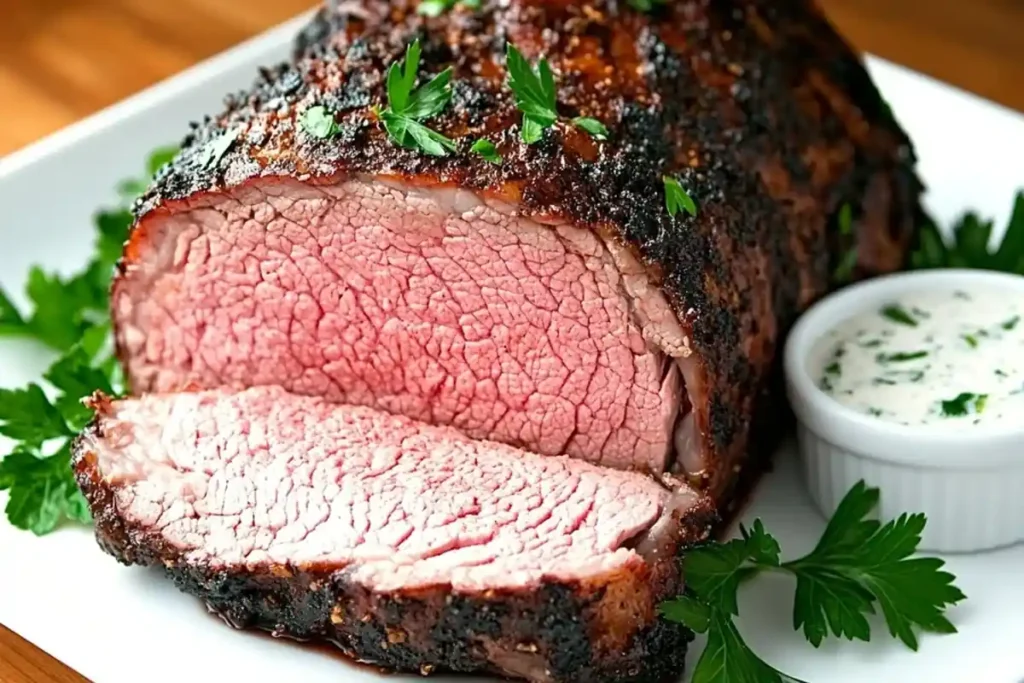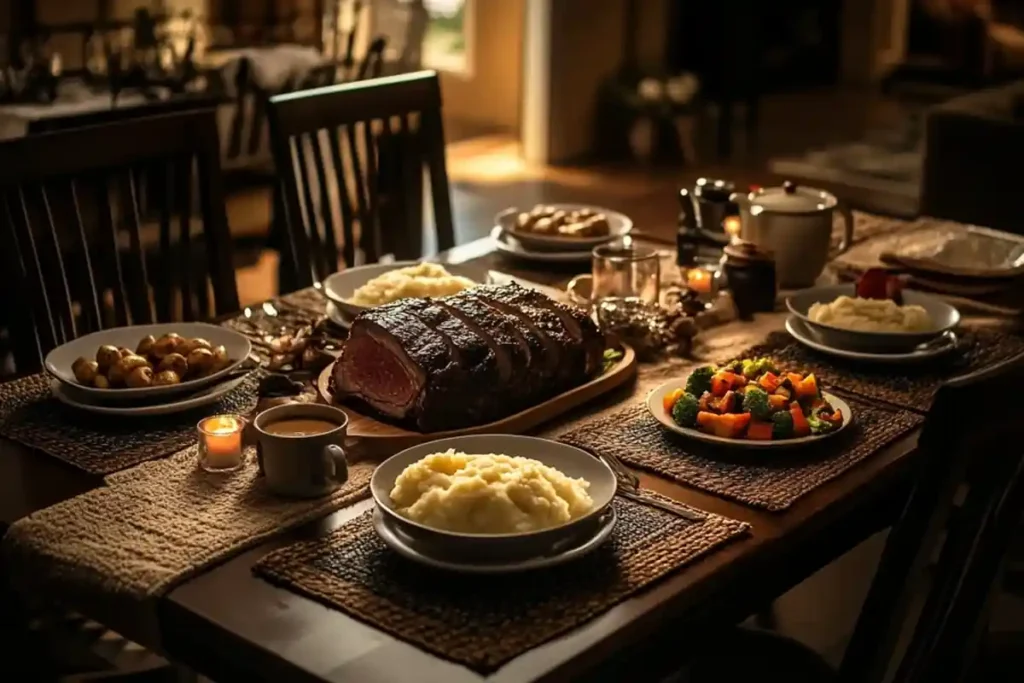A perfectly cooked prime rib is the centerpiece of any celebratory meal. Its rich, tender meat and impressive presentation make it a favorite for holidays and special occasions. In this article, we’ll guide you through everything you need to know about selecting, preparing, and serving the best prime rib. From understanding what makes this cut of beef unique to mastering cooking techniques and accompaniments, you’ll become a prime rib expert. Let’s dive in, starting with the basics.
Understanding Prime Rib
What Is Prime Rib?
Prime rib, often referred to as a standing rib roast, is a cut of beef taken from the primal rib section. This luxurious cut is known for its marbling, which ensures a juicy and flavorful roast. But what exactly sets prime rib apart?
- Definition and Characteristics: Prime rib includes the ribeye muscle and other smaller muscles around it, offering a combination of tenderness and rich beefy flavor. The “standing” rib roast gets its name because it’s typically cooked standing upright on the ribs.
- Prime Rib vs. Standing Rib Roast: While often used interchangeably, “prime rib” usually refers to the cooked dish, while “standing rib roast” describes the raw cut. Both are beloved for their succulence and impressive appearance.
Grades of Beef: Prime vs. Choice
Choosing the right grade of beef is critical for achieving the best prime rib. The USDA grades beef based on marbling and maturity, and the two most common options are:
- USDA Prime: This grade has abundant marbling, resulting in superior tenderness, juiciness, and flavor. It’s perfect for special occasions, though it comes with a higher price tag.
- USDA Choice: Slightly less marbling but still high-quality. Choice-grade roasts can deliver excellent results, especially when cooked properly.
Bone-In vs. Boneless Prime Rib
When deciding between bone-in or boneless prime rib, both options have unique advantages:
- Bone-In: The bones act as a natural insulator, providing even cooking and extra flavor. This is the classic choice for standing rib roasts.
- Boneless: Easier to carve and serve, a boneless roast sacrifices some flavor for convenience. It’s ideal if presentation isn’t a priority.
Selecting the Perfect Prime Rib
Choosing the right prime rib is crucial for a memorable meal. Let’s explore how to select the best cut for your occasion.
How to Choose the Right Cut
Selecting a high-quality prime rib ensures a flavorful and tender roast. Here’s what to consider:
- Identifying Quality Meat at the Butcher: Look for meat with abundant marbling, as the intramuscular fat enhances flavor and juiciness. The color should be bright red, indicating freshness. Don’t hesitate to ask your butcher for a well-marbled, evenly cut roast.
- Optimal Size and Weight for Your Gathering: A general rule is to allocate one pound per person. For larger gatherings, consider a roast with more ribs. Remember, a larger roast may require longer cooking times, so plan accordingly.
Dry-Aged vs. Wet-Aged Prime Rib
Aging beef intensifies its flavor and tenderness. Understanding the differences between dry-aged and wet-aged prime rib can help you make an informed choice.
- Aging Processes and Their Impact on Flavor: Dry aging involves hanging the meat in a controlled environment, allowing enzymes to break down muscle fibers, resulting in a rich, nutty flavor. Wet aging means the meat is vacuum-sealed and aged in its own juices, producing a milder taste.
- Pros and Cons of Each Method: Dry-aged beef offers exceptional flavor but comes at a higher cost due to weight loss during aging. Wet-aged beef is more readily available and less expensive but lacks the depth of flavor found in dry-aged cuts.
Preparing the Roast: Trimming and Tying
Proper preparation of your prime rib sets the stage for even cooking and an appealing presentation.
- Techniques for Even Cooking: Trimming excess fat ensures the seasoning penetrates the meat, while tying the roast with butcher’s twine helps it maintain shape, promoting uniform cooking. Ask your butcher to trim and tie the roast, or do it yourself with a few simple steps.
- Enhancing Presentation and Carving Ease: A well-tied roast not only cooks evenly but also makes carving easier, resulting in attractive, uniform slices that will impress your guests.
By carefully selecting and preparing your prime rib, you’re setting the foundation for a delectable dining experience. Next, we’ll delve into seasoning techniques to elevate your roast’s flavor.
Seasoning Your Prime Rib
Seasoning is key to enhancing the natural flavors of your prime rib. Let’s explore some effective methods to make your roast truly stand out.
Classic Herb and Garlic Rub
A traditional herb and garlic rub complements the rich flavor of prime rib beautifully.
- Traditional Seasoning Blends: Combine fresh herbs like rosemary, thyme, and parsley with minced garlic, coarse salt, and cracked black pepper. This blend infuses the meat with aromatic flavors that enhance its natural taste.
- Application Techniques for Maximum Flavor: Generously coat the entire surface of the roast with the herb and garlic mixture, pressing it into the meat to ensure adherence. For best results, apply the rub at least an hour before cooking, allowing the flavors to penetrate.
Exploring Marinades and Brines
Marinades and brines can add depth to your prime rib, introducing new flavor profiles and enhancing juiciness.
- Benefits of Marinating Prime Rib: Marinades, typically composed of acidic components like wine or vinegar, break down muscle fibers, tenderizing the meat and adding flavor. However, use caution, as over-marinating can alter the meat’s texture.
- Flavor Profiles to Consider: Experiment with marinades that include ingredients like red wine, soy sauce, or balsamic vinegar, combined with herbs and spices to create a unique taste that complements the beef.
Dry Brining: Enhancing Flavor and Juiciness
Dry brining is a simple yet effective method to season your prime rib deeply.
- Step-by-Step Guide to Dry Brining: Generously sprinkle kosher salt over the entire surface of the roast, then place it uncovered on a rack in the refrigerator for 24 to 48 hours. This process allows the salt to penetrate the meat, enhancing flavor and moisture retention.
- Timing and Salt Ratios: Use approximately 1/2 teaspoon of kosher salt per pound of meat. Ensure even coverage, and adjust the brining time based on the roast’s size—longer for larger cuts, shorter for smaller ones.
By mastering these seasoning techniques, you’ll elevate your prime rib to new heights of flavor and tenderness. In the next section, we’ll explore various cooking methods to achieve the perfect roast.
Cooking Methods for Prime Rib
Cooking your prime rib just right is the secret to unlocking its full flavor and tenderness. In this section, we’ll discuss several cooking techniques to achieve the best prime rib every time.
Traditional Oven Roasting
Oven roasting is the classic and most popular method for preparing prime rib.
- Step-by-Step Instructions for Perfect Results: Preheat your oven to 450°F, then season your prime rib and place it on a roasting rack. Start with a high temperature for 20 minutes to create a flavorful crust, then reduce the heat to 325°F and continue cooking until the desired doneness is reached.
- Temperature and Timing Guidelines: Use a meat thermometer to monitor internal temperature. For rare, aim for 120°F; for medium-rare, 130°F. Plan for about 15 minutes per pound at 325°F, but always rely on the thermometer for accuracy.
Reverse Searing Technique
Reverse searing is a modern method that ensures even cooking with a beautifully caramelized exterior.
- Benefits of Reverse Searing for Even Cooking: This technique involves slow-cooking the roast at a low temperature first, then finishing with a high-heat sear. The result? Perfectly even doneness edge to edge with a crispy crust.
- Detailed Process and Tips: Cook your prime rib at 250°F until it reaches 10°F below your desired doneness. Let it rest, then sear in a hot oven (500°F) or on a stovetop for a few minutes per side to achieve a golden-brown crust.
Alternative Cooking Methods
If you’re feeling adventurous, try these less conventional methods for cooking prime rib:
- Sous Vide Prime Rib: Cooking prime rib sous vide ensures precision. Seal the roast in a vacuum bag and cook in a water bath at the exact desired temperature, then finish with a sear for texture.
- Grilling Techniques for Prime Rib: For smoky, charred flavors, grill your prime rib over indirect heat. Use wood chips or a smoker box for an extra layer of flavor. Keep the temperature steady to avoid overcooking.
Mastering these cooking methods will help you consistently produce the best prime rib for any occasion. Now that you know how to cook it, let’s discuss how to nail the perfect doneness.
Achieving the Desired Doneness
Nailing the perfect doneness is a hallmark of a well-cooked prime rib. Whether your guests prefer rare or medium, it’s all about precision.
Using a Meat Thermometer
A meat thermometer is your best ally in achieving perfect doneness.
- Importance of Accurate Temperature Readings: Prime rib is best cooked to a specific internal temperature. A reliable thermometer eliminates guesswork and ensures consistent results.
- Recommended Thermometer Types: Opt for an instant-read thermometer for quick checks or a probe thermometer for continuous monitoring. Make sure to insert it into the thickest part of the meat without touching the bone.
Temperature Guide for Doneness Levels
Different guests, different preferences—here’s how to cater to them all:
- Rare, Medium-Rare, Medium, and Well-Done: For rare, aim for 120°F; medium-rare, 130°F; medium, 140°F; and well-done, 150°F. Always remove the roast when it’s 5-10°F below your target, as it will continue cooking while resting.
- Visual Cues and Internal Temperatures: In addition to temperature, observe the color and texture of the meat. Rare meat will be bright red in the center, while medium is pink throughout with minimal redness.
Resting the Meat: Why It Matters
Resting your prime rib is an often-overlooked but vital step.
- Allowing Juices to Redistribute: After cooking, let your roast rest uncovered for 20-30 minutes. This allows the juices to settle back into the meat, ensuring a tender and juicy slice.
- Optimal Resting Times: As a rule of thumb, rest your roast for 10 minutes per pound. Cover loosely with foil if you’re worried about it cooling too quickly.
By focusing on precision and patience, you’ll serve the best prime rib that’s cooked to perfection and full of flavor. For more inspiration, explore other recipes like beef tenderloin or herb-crusted roast on Your Recipes.

Carving and Serving Prime Rib
Carving and serving your prime rib properly is just as important as cooking it. Presentation and portioning can take your roast from great to unforgettable. Let’s explore the best techniques.
Tools Needed for Carving
Using the right tools ensures clean slices and effortless carving.
- Essential Equipment for Clean Slices: A sharp carving knife or slicing knife is a must. Pair it with a sturdy cutting board, preferably one with a juice groove to catch drippings. A meat fork helps stabilize the roast while slicing.
- Knife Maintenance Tips: Always sharpen your knife before carving. A dull blade can tear the meat, ruining its texture. Honing the knife regularly keeps it in top shape.
Step-by-Step Carving Instructions
Proper carving enhances both the flavor and presentation of your prime rib.
- Removing the Bones: If your roast is bone-in, start by cutting along the rib bones to separate them from the meat. Save the bones—they’re fantastic for making stock or as a treat for the cook!
- Slicing Techniques for Even Portions: With the flat side of the roast facing down, carve into 1/2-inch thick slices against the grain. Cutting against the grain ensures each bite is tender and easy to chew.
Presentation Tips for an Impressive Feast
The way you present your best prime rib can elevate the entire dining experience.
- Arranging Slices on the Platter: Lay slices in a fanned-out arrangement on a large platter. This not only looks appealing but also makes serving easier.
- Garnishing Ideas to Enhance Visual Appeal: Add fresh herbs like rosemary or thyme around the platter. Citrus slices or roasted garlic cloves can also brighten the presentation and complement the flavors of the roast.
With a beautifully carved and presented prime rib, your guests will not only be impressed but will also enjoy every bite. Let’s now pair your roast with perfect accompaniments and sauces.

Accompaniments and Sauces
No prime rib dinner is complete without the perfect side dishes and sauces. These accompaniments highlight the roast’s rich flavor, creating a balanced and satisfying meal.
Classic Horseradish Sauce
A zesty horseradish sauce is a timeless pairing for prime rib.
- Recipe and Preparation Tips: Combine sour cream, prepared horseradish, lemon juice, and a pinch of salt. Mix until smooth, and adjust the horseradish level to suit your taste. Chill for at least 30 minutes before serving to let the flavors meld.
- Pairing with Prime Rib: The tangy, spicy kick of horseradish cuts through the richness of the best prime rib, providing a delightful contrast in flavors.
Red Wine Au Jus
Red wine au jus adds a luxurious touch to your meal.
- Crafting a Rich and Flavorful Sauce: Use the drippings from your roast as a base. Deglaze the roasting pan with red wine, then add beef stock and simmer until slightly reduced. Season to taste with salt and pepper.
- Incorporating Pan Drippings: Strain the sauce to remove solids, ensuring a smooth consistency. Serve warm alongside your carved prime rib.
Side Dishes to Complement Prime Rib
Choosing the right sides can elevate your prime rib dinner to new heights.
- Traditional and Modern Options: Classic options include creamy mashed potatoes, Yorkshire pudding, and roasted vegetables. For a modern twist, try truffle-infused mac and cheese or a fresh arugula salad with shaved Parmesan.
- Balancing Flavors and Textures: Aim for variety. Pair rich and hearty sides with light, crisp salads or citrus-based dishes to balance the meal.
By adding the right sauces and sides, your best prime rib will shine even brighter, making your dinner a memorable occasion.
Common Mistakes to Avoid
Even the best prime rib can fall short if common pitfalls aren’t avoided. By sidestepping these mistakes, you’ll ensure a flawless dining experience.
Overcooking or Undercooking the Roast
Achieving the perfect doneness is a balancing act, but mistakes happen.
- Importance of Monitoring Internal Temperature: One of the biggest errors is not using a meat thermometer. Guesswork can lead to a roast that’s either overcooked or undercooked. Always rely on a thermometer for accuracy.
- Adjusting Cooking Times Accordingly: Remember that cooking times vary depending on the roast’s size and your oven’s accuracy. Check the temperature frequently, especially as it nears completion, to prevent overcooking.
Skipping the Resting Period
Skipping the resting period is a mistake that can ruin even the best prime rib.
- Consequences for Meat Juiciness: Cutting into the roast too soon causes the juices to escape, leaving the meat dry. Resting allows the juices to redistribute, ensuring every bite is tender and flavorful.
- Recommended Resting Practices: Let the roast rest uncovered for 20-30 minutes after cooking. If you’re worried about it cooling, lightly tent it with foil to retain warmth.
Improper Seasoning Techniques
Seasoning plays a crucial role in highlighting the roast’s natural flavors.
- Ensuring Even Flavor Distribution: Some cooks season only the top of the roast, leaving other parts bland. For consistent flavor, coat the entire roast evenly, including the sides and bottom.
- Avoiding Overuse of Salt: While salt enhances flavor, too much can overpower the meat. Use kosher salt sparingly and adjust based on the roast’s size.
By avoiding these common mistakes, you’ll confidently serve the best prime rib every time. Next, let’s tackle some frequently asked questions to clear up any lingering doubts.
Frequently Asked Questions
Prime rib often raises questions for home cooks, and we’re here to provide clear answers. Below are common inquiries about the best prime rib and how to prepare it perfectly.
Does Prime Rib Need Dredding?
“Dredding” refers to coating the roast in flour or other mixtures before cooking. While not necessary, some chefs prefer to dredge their roast for a thicker crust. If you’re aiming for a traditional prime rib, a simple herb and garlic rub is enough.
Is Prime Rib Good for Dinner?
Absolutely! Prime rib is one of the most popular choices for dinner, especially for special occasions. Its tender, juicy meat and bold flavor make it perfect for celebrations or family gatherings. Plus, its versatility allows you to pair it with a wide range of sides and sauces.
What Is Prime Rib Rib?
Prime rib is a cut from the primal rib section of the cow, encompassing ribs 6 through 12. It includes the ribeye muscle and surrounding layers of fat and connective tissue, contributing to its rich flavor and tenderness. When cooked properly, it’s a show-stopping centerpiece.
What Does Prime Rib Taste Like?
The best prime rib offers a robust beefy flavor with a buttery texture, thanks to its marbling. The outer crust, seasoned and caramelized during cooking, adds a savory contrast to the tender, juicy interior. It’s a melt-in-your-mouth experience that’s hard to beat.
With these FAQs answered, you’re well-prepared to serve a stunning prime rib. In the next section, we’ll explore how to store and reheat leftovers while maintaining their quality.
